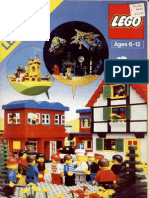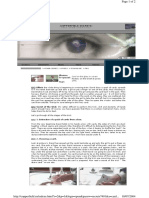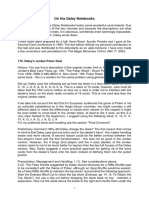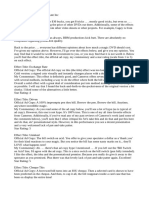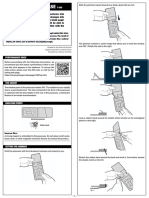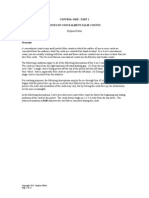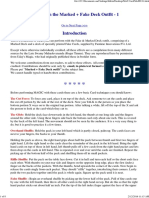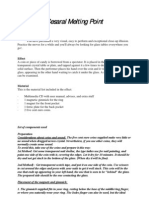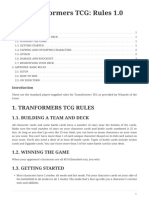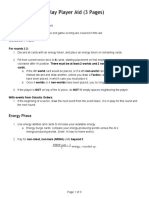Automatic Trick Cards Instructions
Automatic Trick Cards Instructions
Uploaded by
Jasur AbdunabiyevCopyright:
Available Formats
Automatic Trick Cards Instructions
Automatic Trick Cards Instructions
Uploaded by
Jasur AbdunabiyevOriginal Title
Copyright
Available Formats
Share this document
Did you find this document useful?
Is this content inappropriate?
Copyright:
Available Formats
Automatic Trick Cards Instructions
Automatic Trick Cards Instructions
Uploaded by
Jasur AbdunabiyevCopyright:
Available Formats
AUTOMATIC
TRICK CARDS
FEBRUARY 1916, $5 ($107 TODAY)
In the same issue of The Magician Monthly, a statement appeared about DeLand’s next “great” creation. Since it is written
in the form of an enthusiastic report, but not quite a review, the author (certainly DeLand) couldn’t sign his name since he
was also the manufacturer! Despite the debacle with the Wonder Deck, the Automatic Trick Cards shows DeLand putting
his efforts toward a new gimmicked deck to the exclusion of all else. Evidence of how slow his progress was comes from the
discrepancy between the date of the article below, Febru-
ary 1916, and DeLand’s actual date of copyright under the
title “Automatic” at the end of the year, December 8, 1916.
A Five-Dollar Pack of Cards.
De Land’s latest and best pack of cards “for profes-
sional magicians only” is “some” pack. It is sold in its
native country for five dollars; and the price here is
4/2. Some pack!
The pack will grieve the heart of the enthusiastic amateur
who has worked laboriously at many “passes” and false
shuffles and other dodges for keeping certain cards in
certain positions, because this pack will do the work for
him and without giving him a moment’s anxiety.
For example, we will suppose that the conjurer wish-
es to begin his performance with one of the favourite
tricks of the late Charles Bertram. Several persons take a
card apiece, replace the cards and shuffle the pack. The
conjurer can instantly name the cards and, going one
better than Bertram, can cut the pack at the chosen cards
although the pack has been well shuffled by a member of
the audience.
This is only one of many excellent effects which the
conjurer possessing this pack can produce without the The back design of the Automatic Trick Cards greatly enlarged from an image
in the instruction booklet.
slightest effort.
How is it done ? Well, to begin with, the cards are “strippers,” but the printing on the backs is so beautifully done that an
ordinary person, knowing nothing of biseaute cards (or “strippers,” as Americans prefer to call them), would never guess the
secret. You may safely put these cards into anyone’s hands without any fear that that person will discover the fact that the
cards are slightly tapered. The manner of the printing hides the secret. An ordinary biseaute pack is cut after it is printed and
the process of tapering naturally upsets the design of the pattern on the backs of the cards. De Land’s cards are printed after
they are cut, and so all the cards seem to be exactly alike. If the pack were nothing else but a pack of strippers it would be an
excellent pack, but it is much more than that.
The cards are “readers,” both as regards their backs and their edges. The marking is done in the printing, and the method
employed is so good that the secret can safely be trusted to take care of itself. By tilting the cards so that the edges can be seen
easily, the conjurer can at once cut the pack at any card asked for by the audience.
434 DELAND: MYSTERY AND MADNESS
Another effect. Every conjurer knows that if he is working with a pre-arranged pack he can calculate the position of any card
in the pack. But to do this he must first get a glimpse of either the top or bottom card. With this pack in his hand the conjurer
need not trouble to look at the face of any card; all the information he needs in order to present this capital trick he can gain
by looking for a second at the back of the top card.
These cards are of excellent quality, and the printing (both of faces and backs) and the general finish are first-rate; in fact, the
cards could be used at any time as an ordinary pack of cards without risk of anyone disputing the fact. The price is admittedly
high, but not too high for the best pack of trick cards in existence.
DeLand writes about the Automatic Trick Cards as if they’ve already been printed and can be sent to any customer immedi-
ately. But they don’t exist yet.
In his eighth installment (The Conjurors’ Monthly, November, 1945) Walter Gibson wrote at length about DeLand’s Au-
tomatic Trick Cards, a deck which no one has seen but whose instruction booklet exists. (A printer’s proof of both a partial
flattened card case with a card locator dial riveted to it and the Ace of Spades also existed in Gibson’s collection at one time [I
saw them], however these have been lost.) Gibson’s article is worth reprinting here.
DeLand’s Greatest Card Creation By Walter B. Gibson
The zenith of DeLand’s inventive career was reached in the year 1916, after about a decade of high activity. Numerous though
his earlier ideas had been, and ingenious as they were, his famous packs, the marked back Dollar Deck and the edge-reading
Wonder Deck eclipsed his previous efforts. [The Dollar Deck appeared in 1914 and the Wonder Deck appeared in 1915] and
from that time, DeLand began working on a super combination of the two.
Inasmuch as DeLand had worked for years engraving the backs of his Dollar Deck, the three years more required for his Au-
tomatic Trick Cards were really an extension of the earlier period. As to the pack itself, here is what DeLand has to say about
it in his direction sheet:
“Many astonishing tricks can be performed with this pack of cards, the entire secret being in the mechanical arrangement of
the various backs. To the average eye every card has the same back, but upon close examination it will be found that no two
are alike. Although these backs are covered with many peculiar looking characters, each character is mathematically placed
at a certain required position throughout the deck, and the mysterious answers these signals give you almost border on the
supernatural. The student is advised not to attempt to master in one hour this almost inhuman deck. It required a lifetime for
DeLand to originate the effects and engrave the plates for printing it, so our advice to you is to go step by step until you have
thoroughly mastered the meanings of the different characters; then you will realize how mathematics plays with magic, and
afterward will have a ‘friend’ in this deck that will aid you to easily perform the most impossible appearing tricks ever known
in the art of legerdemain.”
Now for a description of the pack itself. The upper left corner and the upper right were equipped with “clock-dials” of the
Dollar Deck type. That in the upper left told the name of the card itself (the top card of the pack) while the upper right
revealed the bottom card when the pack was in the “skip-three” prearrangement [Si-Stebbins order] used with DeLand’s
special packs and Card Locator.
From there on, the marked backs were unique. Instead of dials, the pack had blocks. There were twenty-six of these, mak-
ing thirteen from either end of the pack. The blocks for Jack, Queen, King were between the corner dials; Ace to Ten were
in two rows of five, beneath. The whole back was a flock of tiny symbols which made a meaningless and haphazard pattern
except to the performer. These symbols signified from one to zero and were the sort to be easily memorized. The symbols and
their memory-keys are illustrated herewith. Each block was divided into four imaginary cross-lines, each of which was wide
enough to accommodate two symbols. From top to bottom, the lines stood for Diamonds, Clubs, Hearts, Spades, the suit
rotation in the prearrangement.
Thus to name the location of any card named, the performer first looked for the block that told the card’s value; in that
block, he consulted the line that represented the suit; there, he found two symbols that represented a number from 01 to
52 inclusive.
lasting fame that can’t be counterfeited 435
Our composite diagram tells the whole story. It shows the corner dials representing the Ace of Spades as top card and the
Jack of Hearts as bottom. It gives the value of the blocks, indicates the suit lines, concentrates on a vital symbol in one
block, and also shows another block complete.
The edges of the pack consisted of thin black lines, broken into fives by white spaces and into four sectors by broad black
lines. On every edge, one line had a heavy dot; this showed up like a marker when the pack was gradually spread at an
angle. This was the principle of the edge-reading
Wonder Cards … that enabled the performer to
cut at any card called.
In addition the pack had end marks. These were
cutely hidden in a line of symbols that ran along
the top of each card. Just above the top circle of
each dial, a pair of these symbols gave a num-
ber between 01 and 52. To use these, the Ace
of Spades had to be at the bottom of the prear-
ranged pack. Riffling the pack, the performer
could stop at any spot with a quick glance at the
end of the card where he halted. The symbols
above the left dial would tell the number of
cards in the lower (or left-hand) portion, while
those above the right dial gave the number in
the upper (or right-hand) portion. Thus with
the Ace of Spades, the symbols read 01 and 51,
left and right, but they were different on every
other card. [Note that this appears to be incor-
rect—there are no end marks on the cards. I will
The illustration Walter Gibson had drawn to explain the markings in his article on the
explain this shortly.] Automatic Trick Cards in The Conjurors’ Monthly magazine.
All the vital marks have now been listed, so it is in order to mention those that did not count. The suit symbols in the
corners of the cards were meaningless [note that this is not true, and I will explain this shortly as well]; so were those just
above each dial but below the end line. Nor did the end lines count except for the pairs of symbols already specified. All the
meaningless marks were uniform on every card, hence anyone starting to compare two cards would take it that they were not
specially marked.
In most of the tricks performed with this pack, the Joker was discarded, but it had its own edge mark, over at the right. As to
the use of the pack, it was almost limitless. A list of its various tricks will not be given here, since most of them were common
to the Dollar Deck, Edge Readers, or Strippers, while the rest were really items in themselves, to be considered separately.
However, the use of the pack should be outlined, and as preliminary, its final feature must be included. On every card case
made for this pack was a printed Card Locator, revealing dial and all, of the type described earlier in this series. Thus the pack
really had everything, all in one package!
In using the pack, the performer would begin with some of the Dollar Deck effects, naming top cards of heaps, locations of
various cards, the number in each packet, all dependent on marks and prearrangement. Next he would send the deck out of
the room and repeat those miracles with the aid of the locator. Finally the pack would be shuffled and used as strippers, the
performer continuing to introduce instantaneous locations by the edge-reading method, thus apparently proving that thor-
ough shuffling had been used with the earlier prearranged effects.
Such was DeLand’s miracle pack, the very existence of which had become mere legend until it was recently rediscovered. I
doubt that the pack itself was ever printed, but it must have been practically ready for production when DeLand, despondent
over business difficulties, destroyed many of his plates and sold the rest. I have mentioned in a previous article the reason
436 DELAND: MYSTERY AND MADNESS
DeLand gave for disposing of the plates used with the Wonder Deck, namely that international gamblers were using them.
Since his “Automatics” incorporated edge-marks, it is possible that he junked them at the same time.
However, though I knew DeLand well in later years, I never heard him mention his great “Automatic” masterpiece by name.
In fact, DeLand shrugged off all conversation relating to mechanical cards and talked about tricks of other types, which I
shall describe later in this series.
If ever a secret became well-harbored, it was that of the Automatics, the pack that nobody seemed to know. During the twen-
ties there were magicians who spoke occasionally of a “five dollar” pack that DeLand had created but never put on sale, but
whenever I tried to track down this rumor, it led back to the edge-readers, giving the impression that persons had confused
the super-deck with the Wonder Cards which had already become a rarity.
Now at last the whole story has been pieced together. DeLand actually did invent and complete his Dream Deck, the culmi-
nation of a great career in surmounting the apparently impossible in magical invention. The dozen miniature illustrations
contained in his instruction booklet include complete backs of these remarkable cards and were in all probability reductions
of the originals. Time, expense, and patience are now the only requirements needed for someone to produce this greatest of
all card inventions, since DeLand completed the creative work to the last detail.
Reverting back to the combination chart, some further details are in order. We have not attempted to reproduce an exact
back of this Automatic Pack. To do so would have required an exhaustive piece of art work, confined to the reproduction
of a single back and therefore of no further use. DeLand had such illustrations in his instruction booklet, but they were so
reduced in size that they could not be properly reproduced.
So we shall ask the reader to visualize the actual deck by reference to the combination chart and particularly the “ten block”
as shown there. That panel is done in “white on color” and the same applied to all other panels and the end marks. This has
been shown in the enlarged “numerical strip” that accompanies the combination chart. The corner blocks, indicating top and
bottom cards, were in color, with white dots, instead of color on white, as our chart shows them. Little white marks appeared
all along the ends of the pack. You will notice that in the “Jack block” four lines have been indicated to represent the suits.
Refer to the “four block” and you will see that the artist has inserted two sample symbols, signifying forty-one, indicating that
the Four of Spades would be forty-one cards from the top.
Our “ten block” shows everything, giving the position of every Ten-spot in the stacked deck. Just visualize the whole back
spotted with “keys” like this, and you have the full picture. Those empty panels in the bottom half are identical with the top
group, when the card is turned around, and the end strip, too, would have its corresponding symbols, with one slight variant.
Note the little Club and the little Spade at the extremes of the end strip. They are not marks, but merely ornaments. At the
other end of the pack, DeLand had a Diamond and Heart instead of a Club and Spade. These decorative spots, like the end
symbols themselves, appeared in white on color.
Now for the edge marks. Our chart shows them as they actually appeared, colored lines against a white background. We have
shown the left edge only; the right edge had a similar succession of lines operating in the opposite direction. The heavy lines
indicate the suit divisions, to indicate a card, one of the lighter lines was also thickened, so it would stand out clearly. In the
case of the Ace of Spades, the back that is under discussion, the key line would be the first (or top) line in the fourth (or bot-
tom) group, reading down the edge. It has not been marked in the combination chart, but the system is quite plain.
There is a line for every card in the pack and all were edge-marked accordingly. In a previous article, our full-size illustration
of the Wonder Cards showed how the marks popped up on that strictly edge-reading pack. With the “Wonder” the marks
were white on color and took a rather keen eye to detect. To make them stand out more clearly, DeLand switched to color on
white when he designed the Automatic Pack and the result was unquestionably much sharper.
Now as to the actual existence of the “Automatic Pack.” From the miniature illustrations in DeLand’s instruction booklet, it
seemed a certainty that these cards must have been printed, otherwise so many could not have been reproduced. Some fur-
ther research on the subject has brought the following results.
First, in the Magician Monthly for February, 1916, there appears an article entitled “A Five Dollar Pack of Cards” which at
lasting fame that can’t be counterfeited 437
rapid reading might be taken to refer to the Wonder Cards but which contains two paragraphs identifying it as the “Automatic
Pack.” [The entire article was reproduced at the beginning of this section on the Automatic Trick Cards—Gibson is referring to
the sixth and seventh paragraphs, but he should have named the third paragraph as well.]
The article in the Magician appears to have been a review, rather than an advance notice of the pack, for it commends the
quality of the cards and describes the pack as the best trick cards in existence. However, the pack was not advertised, so we may
assume that DeLand did no more than send out samples to dealers. [Gibson is incorrect here, and it’s surprising that he did not
recognize that the article was written by DeLand and so was not done by someone looking at a deck of printed cards.]
One of the things Gibson describes is what he believes is an uncut sheet of Automatic Trick Cards which came into Ted
Annemann’s possession years earlier:
As to whether there were such samples, here is an enlightening excerpt from a letter that I received from Ted Annemann in Oc-
tober, 1939. Ted wrote: “Remember DeLand’s Wonder Deck—five dollars—the edge readers? Flosso is keeping Duke’s shop open
and I went through a lot of packages and drawers and suddenly walked into a flat package addressed to Clyde Powers and stamped
from DeLand. Wrapped inside was a complete set of the Wonder Cards printed flat with a cardboard cut-out, a flat printed case
and instructions. I never knew it was sold that way. No one knew what they were or had ever seen them so I have the complete set
and wrapper—and we can gloat over them when you come down next. Another thing—that deck was a stripper deck too, and was
marked on the back at one end so you could use as a single ender besides the edge marks.”
When I next saw Ted Annemann, I recall that he mentioned the pack but had put it away somewhere so I told him not to
bother to look for it, because from his letter, I assumed that he was referring to the old Wonder Pack, the simple red-backed
edge-readers, with which I was already familiar, and which Clyde Powers had been one of the first dealers to advertise. But now,
having seen the actual instruction booklet of the Automatic Pack and its flat-printed case, I know that it must have been the
pack that Annemann uncovered. His reference to “end marks” is the clue, for the Wonder Pack did not have them, whereas the
Automatic Pack did. Of course I did not know that at the time, never having seen the Automatic Pack, so I assumed that Ted
had merely noted some secondary feature in the usual Wonder Pack. In fact it seemed of very little consequence, since the cards
were strippers and therefore had no reason to be printed as a one-way pack, so I gave it no further thought. Now I realize that
Annemann must have mistaken the end-marks used in the heap riffle for one-way marks and probably didn’t bother to check
by the instructions. But why would he have made that mistake, considering that the end symbols are the same at each end of
the card? That question has a curious answer. Annemann must have noted those little ornamental spots at the corners of the
cards, the decorations that were not intended as marks at all: a Club and Spade at one end; a Heart and Diamond at the other.
Thus the pack was a one-way pattern and a very neat one, too, something which DeLand apparently did not realize, but which
Annemann discovered!”
I believe Gibson is incorrect. Here is the letter DeLand sent to Clyde Powers which accompanied the flat sheet of cards which
Annemann later found (note that this letter dates from one year after the original Wonder Deck was put on the market):
Mar.3, 1916
Dear Powers:
Many thanks for check for $10 covering goods sent over a few days ago.
I am losing my eyesight from this hard work and suffer with bad attacks of rheumatism. Have mailed you a sample of the
Wonder Deck for your approval. The idea is this: The magician is to place the templet over the back of each card in the prop-
er position and with a hard sharp lead pencil he traces an outline for the stripper card. With a pair of sharp scissors he neatly
trims out the card. I did the Joker as a sample. In this way the whole deck can be cut out in a short time. You can sell the out-
fit for about 25 cents retail and I can let you have them for $10 per hundred sets. The set comprises the entire Wonder Deck.
The U.S. tax will be on the Joker. A folding box, directions and templet. The sheets are celluloid coated as per sample.
Let me know and I will send a hundred sets over.
Best regards,
Theo.
438 DELAND: MYSTERY AND MADNESS
There’s no question, then, that the sheet was a full set of Wonder Deck cards and the “cardboard cut-out” to which
Annemann refers is the template that DeLand cites in his letter. As further evidence of the existence of this type of template
created by DeLand, note the template shown earlier for the Nifty Trick cards—the 25¢ version of the Dollar Deck. My as-
sumption is that Annemann did not see a flat sheet of uncut cards for the Automatic Trick Cards, but the uncut sheet of the
Wonder Deck with a template and flattened card case which we know
DeLand sent to Clyde Powers.
There is a discrepancy in Gibson’s description of the Automatic Trick
Cards. He states that the cards are “end” readers as well as edge readers,
and there are markings on the ends of the deck which are shown and
explained in the instruction booklet. On the following pages you will find
the original instructions for the Automatic Trick Cards. Note that the
ends of the cards are printed with a black band. Because the text within
that black band differs on each end, it’s a One-Way Deck. Not one of the
15 illustrations of the card’s back design in the instruction booklet has
the symbols on the ends which Gibson describes and shows in his arti-
cle. My guess is that Gibson might have misinterpreted figure 11 in the
instruction booklet, which has arrows pointing to the edge of the card.
But when the illustration is enlarged (as you will shortly see), it’s clear
that the arrows actually refer to markings in the quadrants on the back
of the card, not on the ends.
Another point that leads me to assume Gibson is mistaken is the Feb-
ruary 1916 piece in The Magician Monthly which mentions every facet
of the Automatic Trick Cards except the ability to read the ends. The cover of the miniature instruction booklet.
Here, then, is the full text of the miniature instruction booklet for the
Automatic Trick Cards, its size designed so that it would fit inside the card box with the deck.
De Land’s Automatic Trick Cards
The Pack with a ‘Million’ Marks
Magical Masterpiece of Theodore L. DeLand, Jr.
Self Acting, No Skill Required Combination (all in one pack) of Strippers, Edge Readers,
Signal Backs, Card Locators and Dial
Copyright 1916, by The DeLand Playing Card Company
PART I
How to Understand the Secret Marks in This Deck
Prearranged System
Many astonishing tricks can be performed with this pack of cards, the entire secret being in the mechanical arrangement
of the various backs.
To the average eye every card has the same back, but upon close examination it will be found that no two are alike.
Although these backs are covered with many peculiar looking characters, each character is mathematically placed at a
certain required position throughout the deck, and the mysterious answers these signals give you almost border on the
supernatural.
The student is advised not to attempt to master in one hour this almost inhuman deck. It required a lifetime for De Land
to originate the effects and engrave the plates for printing it, so our advice to you is to go step by step until you have
thoroughly mastered the meanings of the different characters; then you will realize how mathematics plays with magic,
and afterward will have a “friend” in this deck that will aid you to easily perform the most impossible appearing tricks ever
known in the art of legerdemain.
lasting fame that can’t be counterfeited 439
When the cards leave the factory they are correctly assorted in the
following manner and then sealed with the government stamp. (See
Fig.1, which is arranged in spiral form simply to save space.) To learn
this arrangement, commence by placing the Ace of Diamonds face up
on the table, and on top of it the remaining cards are all placed faces
up in the order shown. You will note that the suits run Diamonds,
Clubs, Hearts, Spades. To remember this simply note the following
expression
De Land’s Cards Have Superiority.
Diamonds, Clubs, Hearts, Spades.
Each card is just three points higher than the preceding one. For
instance, the Ace of Diamonds comes first, so three points higher for Fig. 1
the next card would demand a Four, which, according to the rule for
suits, would be the Four of Clubs. Go right on in the same way until the arrangement is complete. Always remember that
Jack counts 11; Queen, 12; King, 13.
When the cards are once arranged as mentioned they can be falsely shuffled indefinitely and their order is never broken.
False shuffling is practically the same as cutting, and is done by bringing a solid lower portion of the deck to the top, but
never allowing one or more cards to get mixed with the rest. This can be repeated at will, and with a little practice the
effect is the same as if the cards were really shuffled.
How to Reveal the Location of Any Card Named
(Discard the Joker for this trick.)
After the pack has been prearranged, falsely shuffled, and placed faces down on
the table, ask for some one to name any card. Follow these instructions and you
can easily name the correct location of the chosen card, counting down from the
back of the deck.
The cards are all faces down on the table; look at the back of the uppermost card and
on it at a designated place a secret signal will tell the tale. It makes no difference as to
what card appears at the top, if the deck is arranged in proper order its back will tell
you where every other
card is located.
Note Fig.2, which Fig. 2
explains the signal
system. Look at the upper half only, the bottom half being
the same when the card is reversed. The three top sections
indicate Jack, Queen, King. The next row, Ace, Deuce, Trey,
Four, Five. The next, Six, Seven, Eight, Nine, Ten. Each
section is subdivided into four compartments which you
must consider as Diamonds for the upper one, followed by
Clubs, Hearts, and Spades. Remember this order by the
rule already given.
Within these compartments you will see peculiar looking
characters, apparently placed there for ornamentation, but
in reality, these symbols almost talk to you. To read them is
Fig. 3 simplicity itself, as can be seen by looking at Fig.3.
440 DELAND: MYSTERY AND MADNESS
For instance, some one asks for the location
of the Ten of Diamonds, and we will allow, for
example, that the pack were so arranged that
the top card is the Ace of Spades, which, of
course, is face down. Look at the back of this
card (see Fig.4) at the section indicating 10, and
in the Diamond compartment you will observe
a Triangle for Three, followed by a circle for a
Cipher [zero]. You have only to consider these
Fig. 4 Fig. 5
characters as meaning 30, and then you can feel
safe in stating that Ten of Diamonds is thirty cards down from the back of the deck. As you count the cards do not disturb
their arrangement.
Again, for example, we will allow that the deck is arranged the same way and the King of Spades is named. Look at Fig.5
at the section for King, and in the Spade compartment you will see a Circle for a Cipher [zero] followed by a Pentagon
for Five. In this case when the circle precedes another character it is disregarded and you have only to name the following
character, which is a Pentagon or 5. The King of Spades is the fifth card down in the deck. When a Circle follows a charac-
ter you calculate it as a Cipher [zero].
This rule will never fail, and after a little practice you can name the location of a card almost the instant it is named.
To Name the Bottom Card of Every Pile
(Discard the Joker.)
Have the deck arranged as before mentioned and
falsely shuffle. Place the pack faces down near
the edge of the table and then cut from the pack
a good portion of the cards, making a second
Fig. 6
pile. From the second pile cut a good portion,
making a third pile. Repeat this operation until you have five or six piles running across the table (see Fig.6).
You can now easily perform a miracle that will almost take the breath of any old-time magician. You can name the bottom
card of every pile without seeing those cards. First look at the last pile (for example, we will say that you made five piles).
Note the top card of pile five, and in the upper right-hand corner (see Fig.7) you will see a design representing a circle
composed of small balls. This circle you must consider as representing a clock, each ball designating an hour of time, and
each hour indicates a certain card; for instance, one o’clock means Ace, 2
o’clock, Deuce, etc., up to 10 o’clock for a Ten Spot; 11 o’clock is Jack; 12
o’clock, Queen, and the center ball stands for King. The four balls around
the center indicate the respective suits (see Fig.8). If a ball is missing, that
one is your cue. For example, again look at Fig.6, and in pile five the point-
Fig. 8 er indicates the circle mentioned. A certain ball indicating the number of
spots and one for suits will be found missing. Strange as it may seem, the
card indicated by these signals will be the bottom card of pile one. Next look for the same
circle on the top card of pile one, and it will reveal the bottom card of pile two. The same
circle on pile two tells the bottom card of pile three, three tells four, and four tells five; this
Fig. 7 rule works for any number of piles. Be careful when you replace the piles that five goes on top
of four, both on top of three, and so on until the pack is in the same order as when you started.
The King Trick
(Discard the Joker.)
When the pack is prearranged as before mentioned, a most peculiar mathematical mystery can be shown. No matter what
lasting fame that can’t be counterfeited 441
card appears on the bottom when the deck is cut, you have only to multiply
the spots on it by four and the total will tell the exact location of the King of
the same suit counting down from the back card of the deck. For example,
if the Four of Spades were face up at the bottom the King of Spades would
come (4 x 4), or 16 cards down from the back of the deck.
The Knife Trick
(Discard the Joker.)
Again arrange the deck as mentioned, give it a false shuffle, and request
some one to run a knife point into the pack at any place desired. Like a
flash you can name the two cards above and below the blade. (Note Fig.9.)
When the blade has been inserted at the short end of the pack, slightly shift
the portions above and below the blade so that you can see the two circular
designs on the lower portion. The signal on the right tells the card above the
blade, and the one on the left, the card below.
To Cut the Pack and Name the Number of Cards in Both Piles
Fig. 9
(Discard the Joker.)
Have the pack prearranged as before, and ask some one to cut it into two piles. For example, we will allow that it has been
cut like Fig.10. First look at pile one and note the upper right circle at Section A. It indicates the Six of Clubs. Look at Sec-
tion C in pile two (the correct section for Six of Clubs),
and you will see that the card mentioned is 18 cards
down. Of course, there are eighteen cards in pile two.
Next look at the upper right circle marked Section B
in pile two and it reads Four of Spades. Look at pile
one at the correct section for the Four of Spades and
it reads that the card named is 34 cards down in pile
one, or the bottom card. Of course, you can safely say
that 34 cards are in that pile.
Rapid Counting Trick
(Discard the Joker.)
This effect is considered the Slickest of all, and if per-
formed well will create a profound mystery.
Secretly cut the pack until the Ace of Spades is at the
bottom. You are now prepared to perform a very clev-
Fig. 10
er effect. Hold the pack in your left hand and, with
the right, riffle the upper end of the deck, allowing
each card to rapidly fly from your right hand fingers
(see Fig.11). In a comical manner state that this is the
way you count the cards. To satisfy those present ask
any one to call Stop when you riffle the cards, and al-
though the cards are flying in rapid succession before
your eyes, you, at the word Stop, can instantly name
the number of cards in your left hand. It is only neces-
sary to look at the little space marked A on the upper
half of the cards in Fig.11, and the signals in that
space will always reveal the number of cards in the Fig. 11
442 DELAND: MYSTERY AND MADNESS
lower portion. For example, the cards while being riffled were stopped as illustrated. In this space you see two signals read-
ing 24. There s nothing more to it—you have 24 cards in the lower portion. Should some skeptic quickly ask how many
cards are in the upper portion, simply glance at B and you will see signals reading 28. Enough said, you have 28 cards in
the upper portion. You must remember, however, that this effect works only when the Ace of Spades is at the bottom.
The Mental Test
(Discard the Joker.)
Announce that you will correctly name the location of any card named while you
are alone in another room behind a locked door and the pack left on the table with
your audience.
We will allow, example, that the pack on the table were so left that the signal in
Fig.12 indicates that the bottom card is the Jack of Hearts. You have in your pocket
the original carton in which these cards came, on the back of which is a dial. This
dial is represented by four rings, the first being Diamonds, then Club, Hearts, and
Spades. Each ring represents the full set of cards for its respective suit. The bottom
card of the pack is the Jack of Hearts, so revolve the dial until the J in the Heart
circle is even with the number 52 at the top of the dial. Should some one ask for
the location of the Ten of Diamonds, you simply look at the Diamond circle for 10,
Fig. 12
and opposite to it you will see the number 30. The Jack of Diamonds is 30 cards
down from the back of the pack. Any card called can likewise be located.
The Telephone Test
Previously give some friend (who resides far across the city from where you intend to demonstrate this effect) one of these
dials (we will mail you an extra one for ten cents), together with a copy of the following code:
Brow—Ace Brooks—8
Burns—Deuce Beek—9
Baker—Trey Becker—10
Bates—4 Bell—11 (Jack)
Browning—5 Bender—12 (Queen)
Bright—6 Bennett—13 (King)
Briggs—7
For the respective suits, first names can be used as follows: David stands
for Diamonds; Charles, for Clubs; Harry, for Hearts; Samuel, for Spades.
Announce to your audience that you have a friend gifted with second sight.
You will allow any one present to call him up on the telephone and that he
will correctly name the location of any cards named. For example, we will Fig. 13
allow that the upper right-hand circle on the back of the deck indicates
that the Two of Spades is at the bottom. You simply know by the code that the name Burns means Deuce and Samuel is
for Spades. Ask some one to call up your friend Sam Burns. This individual catches the assumed name and at once sets his
dial so that the Deuce of Spades is even with 52. He can easily read the dial and call back the location of any card named.
PART II
Involving Tricks Performed When the Pack is Really Shuffled
(The Joker can be used in these effects.)
Note Fig.13, and you will observe that the left edge of each card is subdivided into four sections, which are to be consid-
ered as indicating Diamonds, Clubs, Hearts, and Spades. Within each section three little clusters with five lines each (like
in music) will be seen. These lines do miracles for you. Somewhere along the edge of a card one of the lines is heavier
lasting fame that can’t be counterfeited 443
than the rest and that line tells the tale. In Fig.13 the line for the Ace of Spades is heavy. No matter how much the deck is
shuffled, if you simply push the cards over like Fig.14, every heavy line will show up like a dot at some place along the line
on the edge of the pack. As the deck is shuffled these dots shift along like a bead on a thread, but never go out of sight or
off the line, and there can be but one dot on a line. If a card becomes reversed it makes no difference, as the same stunt is
figured out on the opposite edge of every card, running in the opposite direction; so a reverse brings the same effect.
The deck is thoroughly shuffled, and you are to
instantly cut the pack at any card named. For ex-
ample, should some one ask that you cut the Five of
Clubs, look at Fig.14 in the Club section, and on the
fifth line you will see a dot located at some place on
the line. With your left thumb nail grip the cards
below this dot and then cut the cards above the
nail. It’s a cinch that you cut the Five of Clubs. The
Joker is the last line in the Club section. Careful
study of Fig.13 will enable the student to locate any
card desired, and the system is simplicity itself, as
in each section the cards run in consecutive order
according to the lines, as: Ace, Deuce, Trey, Four,
Five (Space), Six, Seven, Eight, Nine, Ten (Space),
Fig. 14
Jack, Queen, King, and then two lines to be disre-
garded except when the Joker is to be located.
To Name Any Card Removed from the Deck
This effect requires practice, but when mastered the performer produces a miracle never known before in card magic.
Offer the deck for some one to remove any card without any one knowing its name. The deck is then to be really shuffled
and returned to you. Do not rush things, but state that if the party that selected the card will impress his mind upon the
same you will receive a mystic answer from the remaining cards as to the one removed. Simply commence to look down
the left edge of the deck for a missing dot. It will take a little time, but you can use patter to fill in the act. For example,
should the card removed be the Queen of Spades, you will soon note that the dot for the twelfth line in the Spade section is
missing, and, of course, you state the correct name of the card withdrawn.
The Top and Bottom Trick
Let the deck be shuffled and placed faces down on the table. Announce that if some one will name the bottom card you
will correctly name the top. This is a ruse. When the pack is first placed on the table you note the clock signal in the upper
left-hand corner, which names the top card, and after appearing to calculate for a while you name it, to the astonishment
of all present. If desired you can have your back turned to the deck.
Stripper Tricks
Close examination will shove that the entire pack is cut taper, that is, one end narrower than the other. If, therefore, the
narrow ends are all one way, and a card is selected by some one of the company, you, unobserved, turn the other end of
the pack toward him (noticing that he does not turn the card) so that when he returns the selected one, the broad end of
that card projects beyond the narrow end of the others, and can be easily felt and withdrawn without looking at the cards.
Should the cards be turned in different directions, after playing a game of euchre, for instance, they can be immediately
brought all one way by taking the extremities in each hand, the back of the cards uppermost, the thumbs on one side, the
two first fingers on the other; press lightly and draw in opposite directions, then lay the one part of the cards on the other
so that the narrow ends are all one way; the pack is then ready for various tricks. It is always best to commence with the
following tricks, as you can have the pack ready prepared for it.
444 DELAND: MYSTERY AND MADNESS
To Separate the Red Cards from the Black at One Cut
Have the pack prepared as follows: The narrow ends of the red cards one way, and the black the other, shuffle them well
and they are ready. Show that the black and red cards are indiscriminately mixed, then take them as before described,
separate the cards by drawing in opposite directions, turn each half so as to bring the narrow ends one way, lay one-half on
the other, and show that all the reds and blacks are separate. The pack is now ready for other tricks.
The Four Ace Trick
Pick out the four Aces, lay them on the table, then place them separately in the pack at different parts (reversing the pack
before doing so). Then give them to be shuffled, take back the pack, put it for a moment behind you, when the Aces can
immediately be withdrawn and slipped into the pocket; give back the pack, saying, “Excuse me, you must pick out the
Aces.” The person will not be able to find them, so you then produce them from your pocket.
To Find a Card in Any Wished Position
Have a card selected, reverse the pack carelessly so as to be unobserved; the card is then returned and the pack shuffled
by some one. Take the pack, put it behind you for a moment, draw the selected card and leave it at the bottom. Now ask,
“How many from the bottom would you like your card to be?” at the same time (holding the pack in your left hand) draw-
ing that card a little toward you with the thumb of the right hand. It is now easy to draw cards from the bottom without
moving the selected one, which can be drawn out at the number desired.
To Make a Selected Card Pass Through a Handkerchief
Allow a card to be selected and returned, as in the previous trick, then holding the pack close to the table, by the extrem-
ities in your two hands, ask some one to throw a handkerchief over the cards. Immediately, when the pack is covered, with-
draw the selected card and leave it on the table, bringing the pack into view, and laying it on the top of the handkerchief,
saying: “It will be better if I leave the pack in sight.” Then ask the name of the card chosen, give the pack a sharp blow,
command the card to go through the handkerchief, which when you gather it up will appear to be the case, as the drawn
card will be seen on the table. Be careful that the handkerchief is thick enough to prevent its being seen through.
The Turned Card
After the card has been returned to the pack and shuffled, place the pack behind you for a moment, or, unobserved, draw
out the selected one, and place it on the top of the pack, then use half of the pack, taking it so as to cover it with the right
hand, the thumb at one end and the four fingers at the other, back of the cards uppermost, push the top card about half an
inch beyond the others with the left thumb, which will not be seen, as your right hand hides the top card, then allowing
them to fall about two feet flat on the table, the air catching the top card will cause it to turn over on top of the pack, which
appears exceedingly strange to those not in the secret.
To Allow a Number of Persons Each to Select a Card, and to Pull Them Out of the Pack One After the Other, or All
at Once, as May Be Desired
Let a number of persons, say four or fire, each draw a card, but, reverse the pack and have each card returned and shuffled
before allowing the next to be selected. When the last card has been returned, you can either draw them out all at once,
and throw them on the table face uppermost, putting the pack under the table or hat, or behind you; or have your hands
covered with a handkerchief, and draw them out, singly, asking that the persons who selected cards to claim theirs as you
show it.
To Allow All the Cards to Fall Except the One Drawn
Have a card selected, reverse the pack as usual, and shuffle, then take the pack at the narrow end, where the wide end of
the drawn card projects, between the thumb and middle finger, holding the back of the cards to the company; it is very
easy to let all the cards but that one fall on the table, then ask what the card was and show it. Now get the cards all one
way, as directed at the commencement.
lasting fame that can’t be counterfeited 445
To Bring the Four Kings Together After Being Separated and Shuffled
Lay the four Kings on the table, reverse the pack unobserved, and lay it on the table also, then place the Kings in different
parts of the pack and allow some one to shuffle. Put the cards out of sight for an instant, and draw out the Kings at once
and place them at the top, ask some one to cut the cards, then say the four Kings are together, which you show by turning
up the cards.
To Pass a Selected Card Through a Table
This trick must be done seated at a table. Have a card chosen, reverse the pack, the card is returned and shuffled. You take
the pack and put it for an instant under the table, when you draw out the card and leave it on your lap. Now lay the pack
on the table, ask the name of the card, then you bring it from under the table, and show that there is no other card of the
same sort in the pack.
It will be easy for a person to invent his own tricks after thoroughly understanding the arrangements of the cards.
PART III
How Mathematics Plays With Magic
These effects only interest those having a liking for mathematical mysteries, but are recommended by the author as a good
brain exercise for any magical enthusiast.
Discard the Joker and again prearrange the cards as mentioned in Part I; casually glance at the upper right-hand circle
signal on the back card, which, of course, reveals the bottom card. Announce that you will name the middle card of the
deck. It is always the same card as the bottom one, only a relative color for suit. For example, if the Deuce of Clubs were
the bottom card, the middle, or twenty-sixth card down from the back, would be the Deuce of Spades.
Mathematical Location of Cards
Falsely shuffle the deck and shift the three top cards so that you can see the upper right-hand circle signal of the four top
cards. For example, we will allow that the deck appears as in Fig.15, and the four circle signals read Deuce of Spades, Five
of Diamonds, Eight of Clubs, and Jack of Hearts. Say that you were asked to name the location of the Trey of Diamonds.
The only Diamond signal you see is the second card signal for the Five of Diamonds. Subtract three from five or two,
multiply two by four (never mind the reason) or eight. You have one
card above the Five of Diamonds signal, so add one to eight or nine. The
Three of Diamonds is nine cards down from the back of the deck. Of
course, you always calculate Jack as 11, Queen 12, and King 13. Again,
should the Ten of Hearts be named, you will note that the only Heart sig-
nal shown in the top four cards is the signal for the Jack of Hearts. Jack
is 11, so subtract 10 from 11, or 1 Four times one are four. Three cards are
above the Jack of Hearts signal, so add (three) to four or seven. The Ten
of Hearts is 7 cards down from the back of the deck.
Sometimes the card named is higher than the circle signal. Simply add 13
to the signal number and proceed as before. Example: Should the Ten of Fig. 15
Clubs be named, add 13 to the signal for the Eight of Clubs, or 21. Subtract
10 from 21, or 11. Multiply 11 by 4 or 44; two cards are above the Club signal, which, added to 44, brings 46. The Ten of Clubs
is 46 cards down.
Special Notices
The student is advised to purchase two of these decks. One is kept all prearranged in the coat pocket and the other can be
shuffled at will. By switching, wonderful effects can be produced.
The design on the back of the Joker is for ornamental purposes only, and the characters are not to be noted at all except in
the case of the shaded lines at the side edges, which are used when locating this card.
446 DELAND: MYSTERY AND MADNESS
You might also like
- Lego 6000 Idea BookDocument86 pagesLego 6000 Idea Bookahhoi78% (23)
- Elfer Raus 11 Starts English GBDocument2 pagesElfer Raus 11 Starts English GBgaurav_singh_mdNo ratings yet
- Pinochle Cheat SheetDocument2 pagesPinochle Cheat Sheetalslush100% (3)
- Cluedo - Detective NotesDocument1 pageCluedo - Detective NotesJoseph MilikNo ratings yet
- Mazzo MedusaDocument13 pagesMazzo MedusaStocazzohNo ratings yet
- DIGITAL GIMMICK (Check EMAIL For Instruction Video) PDFDocument1 pageDIGITAL GIMMICK (Check EMAIL For Instruction Video) PDFThe Impressionist0% (1)
- Faro Booklet PDFDocument1 pageFaro Booklet PDFbongoloidNo ratings yet
- Game of Life Adventure Card Game RulesDocument2 pagesGame of Life Adventure Card Game RulesJamesNo ratings yet
- (Magic) John Bannon - Beyond FabulousDocument4 pages(Magic) John Bannon - Beyond FabulousGiuseppe Di Bianco100% (9)
- The Spectators Card Is ProducedDocument9 pagesThe Spectators Card Is ProducedMagicMan100% (2)
- Jon Racherbaumer - SunkenDocument69 pagesJon Racherbaumer - Sunkenvapemagician1990No ratings yet
- Old Wine in a New Bottle: Classic Card Tricks Spectacularly Re-WorkedFrom EverandOld Wine in a New Bottle: Classic Card Tricks Spectacularly Re-WorkedNo ratings yet
- Mental Card Tricks - Magic Tricks Using the Mind to Impress and AmazeFrom EverandMental Card Tricks - Magic Tricks Using the Mind to Impress and AmazeRating: 5 out of 5 stars5/5 (2)
- Mental Card Mysteries - Thirty-Five Weird And Psychic EffectsFrom EverandMental Card Mysteries - Thirty-Five Weird And Psychic EffectsNo ratings yet
- Un ShuffleDocument60 pagesUn ShufflePrem Jogi0% (1)
- Técnicas: Chapter 1: Fundamental TechniquesDocument5 pagesTécnicas: Chapter 1: Fundamental TechniquesRoberto Barragan100% (1)
- Per Our Customerís Request... : On Pages 30 - 32 of This CatalogDocument64 pagesPer Our Customerís Request... : On Pages 30 - 32 of This CatalogdegrisyNo ratings yet
- Jaysee Silk: Color Changing SilkDocument14 pagesJaysee Silk: Color Changing SilkaeroartonlineNo ratings yet
- Card On Train WindowDocument2 pagesCard On Train WindowTalgar KoksalNo ratings yet
- International Coins Thru TableDocument4 pagesInternational Coins Thru Tableemonteolivabb100% (1)
- Tenyo Magic - The Cash 2022Document2 pagesTenyo Magic - The Cash 2022davidingsNo ratings yet
- 3 and A Half of Clubs CardDocument2 pages3 and A Half of Clubs CardChuckNo ratings yet
- Daleys Notebook The Magic Memories 105Document8 pagesDaleys Notebook The Magic Memories 105AndreaClementePancotti100% (1)
- Cameron Francis - Exchange Rate IncDocument3 pagesCameron Francis - Exchange Rate Incpaul murphy100% (1)
- Daryl - Mismade CardDocument3 pagesDaryl - Mismade Cardtarzan dupontNo ratings yet
- Tenyo Magic - Shocking Pass Case (2024)Document4 pagesTenyo Magic - Shocking Pass Case (2024)davidingsNo ratings yet
- Control Grip False Count - Part 2Document4 pagesControl Grip False Count - Part 2api-243693893100% (1)
- Magic MagazineDocument1 pageMagic MagazineJoe MckayNo ratings yet
- Magic TricksDocument6 pagesMagic Tricksfsuarez4048No ratings yet
- Subliminally YoursDocument9 pagesSubliminally YoursTomas Giammarco100% (1)
- Control Grip False Count - Part 1Document11 pagesControl Grip False Count - Part 1api-243693893100% (1)
- A Lesson in Card Handling 4 5 7: Today."Document3 pagesA Lesson in Card Handling 4 5 7: Today."the4power100% (1)
- Enjoy !: From The Magic Man Self Working Card Magic Series # 2effect # 1Document1 pageEnjoy !: From The Magic Man Self Working Card Magic Series # 2effect # 1MagicManNo ratings yet
- The Quick ChangeDocument7 pagesThe Quick ChangeMagicMan100% (1)
- Card Warp Card Illusion PDFDocument1 pageCard Warp Card Illusion PDFBabrikowski Lucas100% (1)
- Arthur ChanDocument6 pagesArthur ChanmagicpalNo ratings yet
- Solo Aces - HTMDocument5 pagesSolo Aces - HTMFaeGiNNo ratings yet
- Dai Vernon Revelations ManuscriptDocument50 pagesDai Vernon Revelations Manuscripthfj100% (1)
- Tricks With The Marked + Fake Deck Outfit - 1: Go To Next PageDocument8 pagesTricks With The Marked + Fake Deck Outfit - 1: Go To Next PageTito Banerjee100% (1)
- Viennamagic Produktliste1001Document29 pagesViennamagic Produktliste1001Staicu Dan CostinNo ratings yet
- Cyrus Kiani - The Soft Spot - Gatorade Cap in BottleDocument5 pagesCyrus Kiani - The Soft Spot - Gatorade Cap in Bottledigdo10No ratings yet
- Daniel MadisonDocument5 pagesDaniel MadisonBuma Moldovan33% (3)
- Anon - A Knotty Routine PDFDocument9 pagesAnon - A Knotty Routine PDFLeah ArnoldNo ratings yet
- MagicWallet PDFDocument4 pagesMagicWallet PDFSharishaNo ratings yet
- BackstoryDocument24 pagesBackstorygiacomoNo ratings yet
- Fallen Angel 1Document1 pageFallen Angel 1PreeningNinnyNo ratings yet
- Fred Kaps. International Coins Throung TableDocument1 pageFred Kaps. International Coins Throung TableGeorgio WaanNo ratings yet
- Stop Me Anywhere: Here Is Your Free Magic Trick!Document2 pagesStop Me Anywhere: Here Is Your Free Magic Trick!degrisy100% (2)
- Delawrence, George - Handkerchief Tricks That You Can Do - 1921 - 48 P.Document48 pagesDelawrence, George - Handkerchief Tricks That You Can Do - 1921 - 48 P.jackson215100% (1)
- 近景教学Document3 pages近景教学harry magicalNo ratings yet
- Later Magic 00 HoffDocument560 pagesLater Magic 00 HoffLuis MiñoNo ratings yet
- CARBONE Angelo Cue The MagicDocument6 pagesCARBONE Angelo Cue The MagicNoNoNo ratings yet
- Cesaral Melting PointDocument5 pagesCesaral Melting PointMacovei Laura100% (1)
- Batteries Not IncludedDocument1 pageBatteries Not IncludedSai NathNo ratings yet
- More Card Manipulations Vol. 4 (Jean Hugard) (Z-Library)Document60 pagesMore Card Manipulations Vol. 4 (Jean Hugard) (Z-Library)potiw11419100% (1)
- Revolutionary Card Technique TocDocument1 pageRevolutionary Card Technique Tocscribdman1No ratings yet
- Doug Edwards - Rubber BanditDocument4 pagesDoug Edwards - Rubber Banditfata123No ratings yet
- Purple Deck Directions: Print This The EffectDocument4 pagesPurple Deck Directions: Print This The EffectIvan Satria Budipramana100% (2)
- The Aces On Bridge 2011 - Bobby Wolff PDFDocument372 pagesThe Aces On Bridge 2011 - Bobby Wolff PDFLingofone100% (1)
- Transformers TCG: Rules 1.0Document4 pagesTransformers TCG: Rules 1.0jobentyNo ratings yet
- Core Worlds Soloplay Player Aid (3 Pages) : Galactic PhaseDocument3 pagesCore Worlds Soloplay Player Aid (3 Pages) : Galactic PhaseenulamNo ratings yet
- Goblin Teeth Print and PlayDocument15 pagesGoblin Teeth Print and PlayRevolver123No ratings yet
- Reglas Ensalada de PuntosDocument8 pagesReglas Ensalada de PuntosMarcia Adriana Durán Castro100% (1)
- Munchkin Marvel Solo RulesDocument1 pageMunchkin Marvel Solo RuleskocirekNo ratings yet
- Name: Teacher: Date: Score:: Probability With A Deck of CardsDocument2 pagesName: Teacher: Date: Score:: Probability With A Deck of CardsVandana Gupta0% (1)
- David Forrest - AutobahnDocument14 pagesDavid Forrest - AutobahnDavide Corona100% (2)
- Dungeon Alliance Solo Variant: RulesDocument1 pageDungeon Alliance Solo Variant: Rulesthomas ulasichNo ratings yet
- Tamariz Memorized Stack and Acaan Trainer PDFDocument32 pagesTamariz Memorized Stack and Acaan Trainer PDFMuhammad TaahaNo ratings yet
- Bang! & Dodge City Cards - Player AidDocument2 pagesBang! & Dodge City Cards - Player AidVahid Mustafazade100% (1)
- Cheat SheetDocument1 pageCheat SheetKishor SinghNo ratings yet
- Interference After Major Opening (803766)Document3 pagesInterference After Major Opening (803766)arunk6100% (1)
- Bricq Worksheets Free ThrowDocument1 pageBricq Worksheets Free ThrowJoryal Gestión AcadémicaNo ratings yet
- Rulebook 2Document6 pagesRulebook 2Brett HillNo ratings yet
- Assignment In: H.O.P.EDocument4 pagesAssignment In: H.O.P.ELeanne Nequia100% (1)
- T TP 1686052018 Paw Patrol Paws and Think Memory Activity Ver 2Document14 pagesT TP 1686052018 Paw Patrol Paws and Think Memory Activity Ver 2alisa.al.azawiNo ratings yet
- Android Netrunner - Cards List - AcooDocument140 pagesAndroid Netrunner - Cards List - AcooIvo PantaleaoNo ratings yet
- Poker Hand Rankings: What Beats What in Poker?Document1 pagePoker Hand Rankings: What Beats What in Poker?Sangram JoruleNo ratings yet
- Crown-Rivals-Rules - v1 0 1Document3 pagesCrown-Rivals-Rules - v1 0 1jakeNo ratings yet
- 34emag July 2005Document32 pages34emag July 2005Vault VaultNo ratings yet
- 136 - Three Card PokerDocument8 pages136 - Three Card PokerTafieNo ratings yet
- 3 PattiDocument3 pages3 Pattiaviroy_kolkatanNo ratings yet
